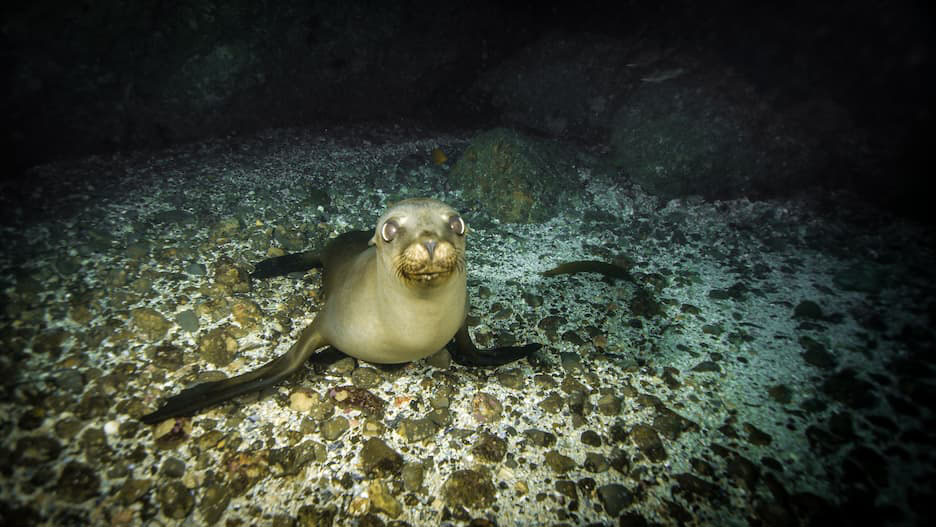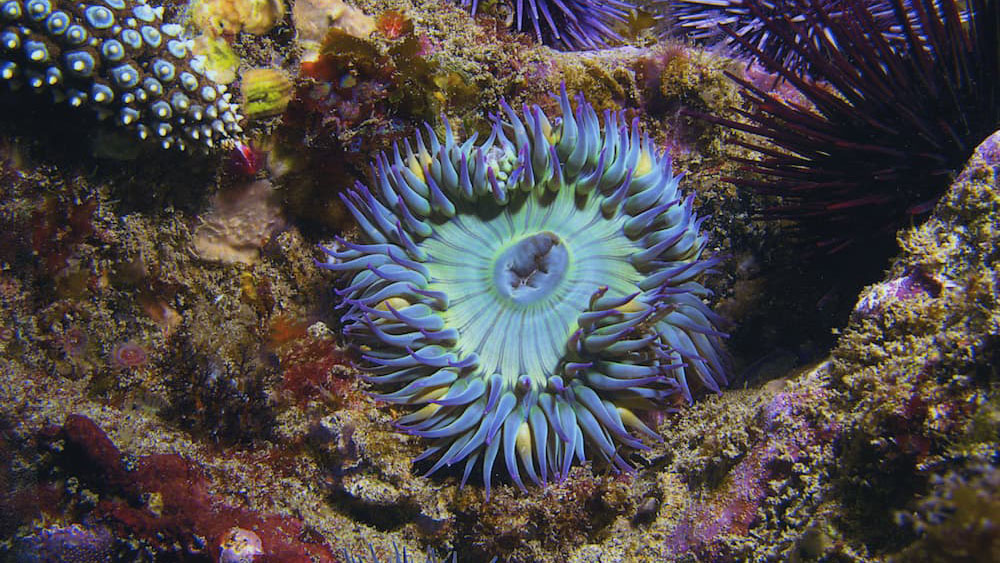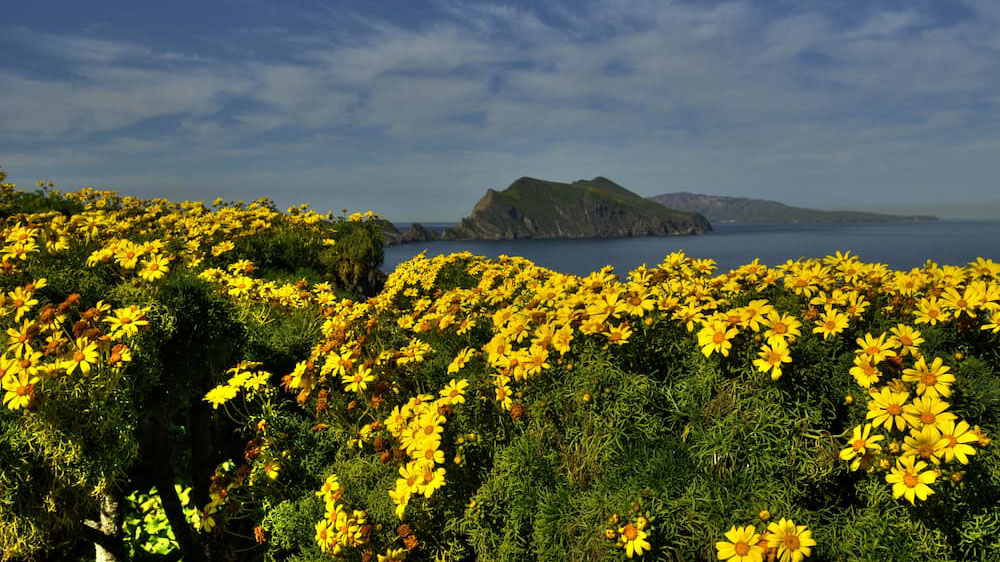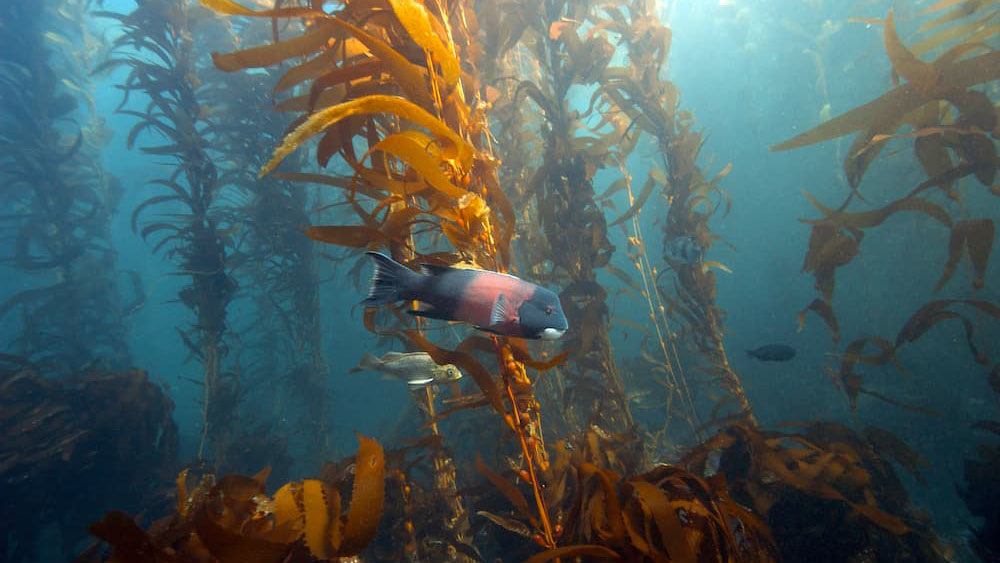What Will I See

Channel Islands National Marine Sanctuary offers wonderful kayaking and boating opportunities to explore the islands' sea caves and enjoy breathtaking views of scenic coastlines. Check out the Protecting Your Channel Islands Brochure for detailed maps of each island, and information on species of interest, dive spots, marine protected areas, harbors, and anchorages. Our responsible wildlife viewing guidelines will help you have a memorable experience and keep wildlife out of harm's way.
With the Channel Islands National Park's live underwater camera at Anacapa Landing Cove, you can explore the kelp forest without getting wet!
Sanctuary waters offer year-round wildlife viewing opportunities.
-
Twenty-seven different species of whales and dolphins visit or call Channel Islands National Marine Sanctuary their home including the world's largest congregation of blue whales. Other species include fin, humpback, and gray whales. Common dolphins, orcas, and Risso's dolphins also frequent the region.
Five species of pinnipeds, including California sea lions, elephant seals, and harbor seals depend on the sanctuary for feeding and breeding.
Sixty species of seabirds including the rare Scripps's murrelet and California brown pelican nest, feed, and migrate here.
Seasons in the Sanctuary
Find out what you might see during different times of the year in Channel Islands National Marine Sanctuary.
Winter

Most of the annual rainfall in the Channel Islands region occurs from December to March. Some of the best sunsets of the year occur during this time. The winter months are excellent for tidepooling because afternoon low tides expose marine algae and invertebrates (November-February).
Gray whales (Eschrichtius robustus) travel through Channel Islands National Marine Sanctuary on their migration from Alaskan feeding grounds to warm calving lagoons in Baja California, Mexico (December-February).
California brown pelicans (Pelecanus occidentalis californicus) begin nesting on Anacapa and Santa Barbara Islands (January-February).
Northern elephant seal (Mirounga angustirostris) pupping and breeding season on San Miguel Island (January-February).
Pacific harbor sea (Phoca vitulina) pupping season on San Miguel Island (February-May).
Spring

Upwelling season begins with persistent northwest winds pushing surface waters offshore and drawing in cold, deep, nutrient-rich waters to Channel Islands National Marine Sanctuary.
During early spring, island wildflowers such as the Giant Coreopsis (Coreopsis gigantea) are in full bloom (March-early April).
Gray whales (Eschrichtius robustus) migrate north through Channel Islands National Marine Sanctuary from calving grounds in Baja California, Mexico to Alaskan feeding grounds (Mid-February to May).
Pacific harbor seal (Phoca vitulina) pupping season on San Miguel Island (February-May).
Peak egg-laying season for California brown pelicans (Pelecanus occidentalis californicus) on Anacapa and Santa Barbara Islands (March-April).
Western gulls (Larus occidentalis) begin nesting on the Channel Islands. (May - July)
Scripps's murrelets (Synthiboramphus scrippsi) breed and nest on the Channel Islands (March-July).
Island fox (Urocyon littoralis) pups are born in early spring on the Channel Islands (March-April).
Double-crested cormorants (Phalacrocorax auritus) begin nesting on the Channel Islands. [Location Santa Cruz Island]
Red-necked phalaropes (Phalaropus lobatus) can be seen in the Santa Barbara Channel in the spring (April-May) and fall (August-October).
Blue Whales (Balaenoptera musculus), fin whales (Balaenoptera physalus) and sei whales (Balaenoptera borealis) arrive in Channel Islands National Marine Sanctuary to feed on krill from the nutrient rich, upwelled water (late May-September).
Humpback whales (Megaptera novaengliae) feed in rich, upwelled waters of Channel Islands National Marine Sanctuary (May-August).
Least terns (Sterna antillarum browni) can be seen in the Channel Islands Region (May-August).
Pink-footed shearwaters (Puffinus creatopus) and sooty shearwaters (Puffinus griseus) visit the Santa Barbara Channel from the southern hemisphere (May-October).
Ashy storm-petrels (Oceanodroma homochroa) and black storm-petrels (Oceanodroma melania) visit the Santa Barbara Channel (mid-May to mid-October).
California sea lion (Zalophus californianus) pupping and breeding season (May-July).
Summer

Dense fog is common during May and June. Afternoon winds are common. Calm winds and seas become more frequent near the end of summer. Fog diminishes near midsummer. Underwater visibility increases.
Ocean temperature begins to warm reaching the high 60s (F) by the end of the summer. Backcountry beach camping season begins on Santa Rosa Island. Seabird and landbird chicks begin to fledge (leave the nest and fly).
Humpback whales (Megaptera novaengliae) feed in rich, upwelled waters of Channel Islands National Marine Sanctuary (May-August).
California sea lion (Zalophus californianus) pupping and breeding season (May-July).
Scripps's murrelets (Synthiboramphus scrippsi) breed and nest on the Channel Islands (March-July).
Blue whales (Balaenoptera musculus), fin whales (Balaenoptera physalus), and sei whales (Balaenoptera borealis) can be observed in Channel Islands National Marine Sanctuary feeding on krill from the nutrient rich, upwelled water (late May-September).
Pink-footed shearwaters (Puffinus creatopus) and sooty shearwaters (Puffinus griseus) visit the Santa Barbara Channel from the southern hemisphere (May-October).
Ashy storm-petrels (Oceanodroma homochroa) and black storm-petrels (Oceanodroma melania) visit the Santa Barbara Channel (mid-May to mid-October).
Least terns (Sterna antillarum browni) can be seen in the Channel Islands region (May-August).
Fall

Warm weather, calm winds and seas are common in the early fall months. This is the best time of year for snorkeling, kayaking, and diving. Underwater visibility can reach 100 feet.
Jellies of all kinds are abundant in California's coastal waters as the oceanic season begins and upwelling winds start to relax, such as the purple-striped jelly. (August-November).
Red-necked phalaropes (Phalaropus lobatus) can be seen in the Santa Barbara Channel in the spring (April-May) and fall (August-October).
Blue whales (Balaenoptera musculus), fin whales (Balaenoptera physalus and sei whales (Balaenoptera borealis can be observed in Channel Islands National Marine Sanctuary feeding on krill from the nutrient rich, upwelled water (late May-September).
Humpback whales (Megaptera novaengliae) feed in rich, upwelled waters of Channel Islands National Marine Sanctuary (May-August).
Pink-footed shearwaters (Puffinus creatopus) and sooty shearwaters (Puffinus griseus) visit the Santa Barbara Channel from the southern hemisphere (May-October).
Ashy storm-petrels (Oceanodroma homochroa) and black storm-petrels (Oceanodroma melania) visit the Santa Barbara Channel (mid-May to mid-October).

